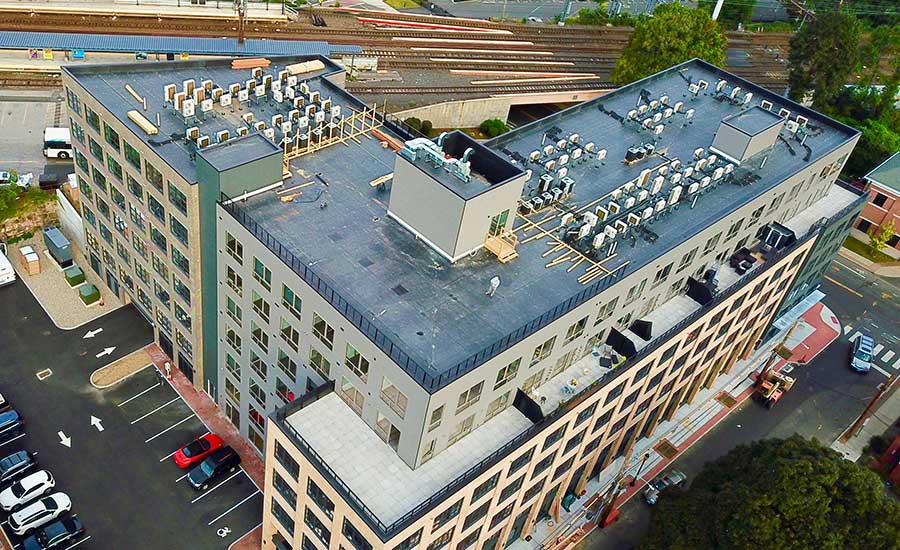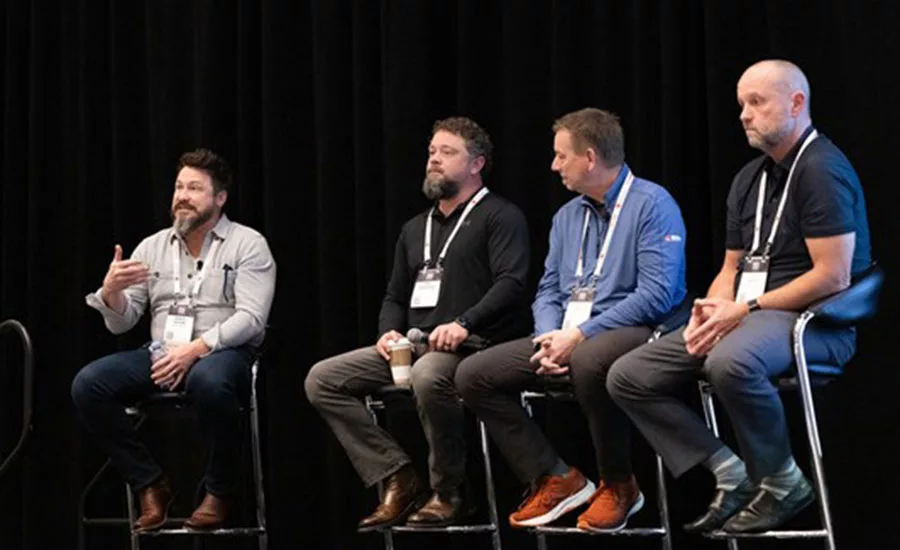Sponsored by Adams and Reese
2023 State of the Roofing Industry Report
February 3, 2023
Sponsored by Adams and Reese
2023 State of the Roofing Industry Report
February 3, 2023An active storm season and optimal weather conditions kept roofing contractors working throughout the past year, but it wasn’t enough to cushion them from supply chain challenges mixed with rising fuel and material costs.
Combined with a still-aging workforce and fewer qualified workers, it’s an understatement to say it’s been a tough year for the roofing industry. Even so, roofing contractors aren’t backing down, as our 2023 State of the Industry survey results show.
Through the use of technology, creative hiring methods and material management tactics, the majority of roofing contractors anticipated 2022 sales to outpace 2021, and even more expect that trend to continue for the next three years.
 Metal roofing is the second best revenue generator at 81% for residential and 82% for commercial.
Metal roofing is the second best revenue generator at 81% for residential and 82% for commercial.Photo: CMR Construction & Roofing.
OPTIMISTIC SALES
Of those who are primarily residential contractors, 71% expected their sales to slightly or greatly increase from 2021. When looking forward, the exact same percentage anticipate 2023’s sales to increase over 2022. Only 18% expect their sales to stagnate in the coming year, while 11% anticipate their sales to slump.
Residential contractors are optimistic about the next three years, though less so than last year. A total of 74% anticipate their sales will increase through 2026. This is slightly lower when compared to last year, where 80% expected sales to increase.
Survey respondents on the commercial side were largely pleased with sales volume growth from 2021, including 72% that reported increased sales over the past year. That seemed to fuel optimism for the near future. Just as many (72%) said they anticipate growth in total sales volume next year, and another 79% anticipate growth through 2025.
Roughly 11% of commercial contractors said they expected total sales volume to drop in 2022 compared to last year, and another 8% and 7% said they anticipate sales to drop this year and over the next three years, respectively. That’s slightly more than what respondents said to the same question last year.
As to what fuels those sales, steep-slope asphalt shingle roofing systems remain the top revenue driver for residential contractors, with 83% listing it as their primary source, up from 77% last year. Eighty-five percent of commercial contractors say single-ply is their top source, which is a slight decrease from last year (90%).
Looking for a reprint of this article?
From high-res PDFs to custom plaques, order your copy today!
On both the residential and commercial sides, metal roofing is the second best revenue generator at 81% and 82%, respectively. These are slightly higher than last year’s results (78% and 81%), suggesting more consumers are looking toward the sustainability that metal provides.
When broken down further, architectural standing seam is the most popular product (38%) on both sides of the industry, which was also last year’s top metal product. Roof edge and gutter systems are next, comprising 21% of residential metal sales and 34% of commercial metal sales. These are followed by structural standing seam (19%) and metal architectural products like shingles and tiles (15%).
Rounding out the top five products for residential are single-ply roofing (73%), low-slope asphalt (59%) and coatings (57%). For commercial sales, the remaining top five are coatings (66%), low-slope asphalt (64%) and steep-slope asphalt shingles (44%). Though overall sales remained in the single digits (8%) the number of commercial roofing contractors in the survey using coatings exceeded 60% – surpassing both low-slope and steep-slope asphalt for the first time in RC’s survey.
Solar continues to generate a lot of buzz, but it isn’t a primary source of revenue for roofing contractors as of yet. Only 20% of residential and 11% of commercial contractors list it as a source of revenue – lower than last year’s 25% and 17%, respectively. That said, commercial contractors said solar sales increased by 71% in 2022, by far the highest category jump in the survey, ahead of spray polyurethane foam (59%), coatings (52%) and metal (51%). It may be difficult to maintain that momentum judging from survey results.
When projecting sales trends for 2023, both residential and commercial contractors anticipate solar to decline. Just over half (56%) of residential contractors expect solar sales to increase despite their sales increasing in 2022 compared to 2021 (76%). Commercial contractors are even less confident in solar sales. Despite the increase in 2022, only 51% say they expect solar sales to increase this year.
Further examining the same question about projected sales from the 2021 State of the Industry, only 47% of residential contractors expected an increase in 2022 solar sales and 51% of commercial contractors anticipated the same. When paired with the actual results, solar sales were higher than anticipated. Given the incentives provided by the Inflation Reduction Act for green solutions, contractors may want to keep a close eye on the solar market.
 Steep-slope asphalt shingle roofing systems remain the top revenue driver for residential contractors, with 83% listing it as their primary source.
Steep-slope asphalt shingle roofing systems remain the top revenue driver for residential contractors, with 83% listing it as their primary source.
Photo: Reliant Roofing, Solar, & Hurricane Shutters
OVERCOMING SUPPLY SHORTAGES
The optimism for future sales are in spite of challenges on multiple fronts that impede operations, the largest of which is supply chain woes. Unfortunately, the survey results show few signs of it slowing down.
Increased material costs is the top perceived challenge (55%), down from 71% in last year’s survey. While this is hopeful, 51% of contractors say supply chain and material shortages are a top challenge, up from 46% last year.
To put a finer point on it, cost increases caused by supply chain shortages are having the biggest impact on contractors (81%), followed by project delays (73%). The delays are hitting the commercial side harder, with 82% of commercial contractors listing it as a problem compared to 67% of residential.
The next largest impact due to supply shortages is hard-to-get materials at 71%, followed by planning difficulties (59%). Finding alternative products or suppliers (58%) rounded out the top five issues.
It’s worth noting that, in last year’s survey, 23% of contractors said supply shortages have had little to no impact. In this year’s survey, only 5% reported little to no impact, illustrating just how serious the problem became in a matter of one year.
Unlike last year, concerns about inflation and the economy rounded out the top three largest challenges, with 47% of respondents listing it. This bumped last year’s issue of lack of qualified workers to fourth at 42%, down from nearly half (49%).
In a new inquiry for this year’s survey, contractors were asked to list anticipated lead times for roofing product deliveries. Most said one to four weeks (42%). The majority of that response came from residential. Another 30% said five to eight weeks, 17% said nine to 12 weeks, and 12% listed more than 12 weeks.
Despite these issues, 57% of respondents said they hadn’t switched manufacturers in the past year compared to 43% who did. Of those who said they switched, the most popular reason was due to availability, which was influenced by long lead times or another supplier simply having the products they needed to finish the job.
Product availability was followed by cost, customer service and better offers for the reasons contractors switched.
 Cost increases caused by supply chain shortages are having the biggest impact on contractors, followed by project delays.
Cost increases caused by supply chain shortages are having the biggest impact on contractors, followed by project delays.Photo: All in One Construction Group LLC.
WORKFORCE WOES
Although supply issues are top of mind, labor issues haven’t taken a back seat. Put simply, contractors say it’s tougher to find workers and retain them compared to last year. However, concerns over COVID have lessened, in part from the widespread availability of vaccines and the relaxing of national, regional and local health guidelines.
Contractors struggling with workforce issues say finding and recruiting new workers is the toughest aspect of workforce challenges (72%), followed by COVID-19 related concerns (50%) and retaining employees (45%). When compared to last year, COVID was the top concern (70%), followed by finding and recruiting labor (64%) and employee retention (38%).
The price of labor hasn’t eased workforce challenges. Four in five respondents report an increase in labor costs since January 2022. Of them, 40% say those increases ranged from 11 to 20%. Thirteen percent say it’s jumped up by 21 to 30%, while 10% said costs have gone up by more than 30%.
Contractors are turning to employee referrals as the best source for alleviating labor issues (73%), followed by referrals from family and friends (64%). The digital realm is also proving to be a popular remedy, with contractors equally turning to social media sites and online job postings to recruit workers.
To retain the employees they do have, contractors say the most effective solution they turn to is paying them well and/or giving bonuses (77%). Finding enough work for employees came second (68%), while ensuring a safe work environment (65%) was third.
More than half (55%) of respondents said providing training was one of their top methods of retaining employees. Training is largely provided in-house while on the job (79%), followed by in-house formal training programs (50%). When turning to outside sources, manufacturer training is the most popular at 34%, while 34% turn to association training, such as the National Roofing Contractors Association.
Subcontractors remain a solution as well, with 29% of contractors increasing the use of them in the past year. The average amount of field labor done by subcontractors was 29%, compared to 62% done by full-time employees.
 Four in five respondents report an increase in labor costs since January 2022.
Four in five respondents report an increase in labor costs since January 2022. Photo: Benton Roofing Inc.
TECH TALK
Technology is another key factor in developing workers and making current workers more efficient. Estimating software, aerial measurement and enterprise or accounting software were the most commonly used technologies identified by contractors.
This tracks with last year’s results, where estimating and accounting software made the top three along with customer relationship management (CRM); however, more than half (54%) of contractors selected aerial measurement tools this year, a jump of 14%. The number of contractors using CRMs dropped to 33%, and was surpassed by drones. Roughly 38% of contractors identified using drones, and another 25% indicated they plan to add or upgrade their drone situation in 2023.
Almost half (41%) of all respondents said they currently use drones, and 10% are discussing adding drones within the next five years, up by 5% from last year. Of the ones that use drones, 87% say they own and operate their own, and 13% lease the equipment. The drones are used, on average, on about a third of all projects, and for purposes like documenting before-and-after roof repairs and replacements; inspections; marketing and thermal imaging. Only 16% have no plans to use drones at all in their roofing business.
 Drones are used for before-and-after shots as well as marketing and thermal imaging.
Drones are used for before-and-after shots as well as marketing and thermal imaging. Photo: Westfall Roofing
CONCLUSION
After two rather difficult years of pivoting due to a pandemic, supply issues and inflation, roofing contractors remain optimistic about the future. Supply chain and material price issues are receding, but not nearly fast enough to make up for lost time and opportunities.
Concerns over an aging and dwindling workforce that may be further impacted by recession fears are very high. While individual, regional and national training programs are underway to bolster the workforce, participants won’t have much experience and may not be ready in time to truly maximize the demand for labor in roofing.
Roofers investing in sustainability may benefit from energy-friendly projects funded through the Inflation Reduction Act. But they’ll need highly-efficient and well-trained workers to meet any spikes in roofing demand.
The information contained within this article is comes from: Clear Seas Research. 2022 Roofing Contractor Roofing Report. Oct. 2022.Clear Seas Research is a full service, B-to-B market research company focused on making the complex clear. Custom research solutions include brand positioning, new product development, customer experiences and marketing effectiveness solutions. Clear Seas offers a broad portfolio of primary, syndicated research reports and powers the leading B-to-B panel for corporate researchers, myCLEARopinion Panel, in the architecture, engineering, construction, food, beverage, manufacturing, packaging and security industries. Learn more at clearseasresearch.com.











